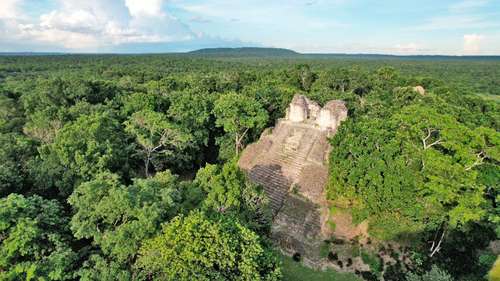Researchers from the National Institute of Anthropology and History (INAH) discovered three facades with reliefs in the archaeological zone of Dzibanché, located in the south of Quintana Roo.
Through a statement, the organization reported that these ancient finds will help to better understand the Kaanu’l dynasty, which inhabited that area from 250 to 650 AD, especially everything related to the representations of their ancestors, mythical animals and power systems.
Under the symbol of the snake (kaan, in Mayan), this lineage governed numerous lordships in the territories currently occupied by Mexico, Belize and Guatemala.
The discovery of these elements was possible due to the research and conservation work carried out by the INAH through the Program for the Improvement of Archaeological Zones (Promeza), parallel to the Mayan Train project.
The regional head of Promeza, Sandra Balanzario Granados, explained that the platforms correspond to two substructures located in the west of Ball Court II of that pre-Hispanic settlement.
The archaeological zone of Dzibanché has the shape of two platforms, whose facades are richly decorated with reliefs modeled in stucco.
Below these platforms you can see scenes of two guardians limiting a pedestal on which a sculpture must have been placed, and which date from between 500 and 600 AD, which coincides with the rise of the Mayan city; The particularity of the podium is that it incorporates glyphs alluding to a ruler of that ancient dynasty.
In the second, images of individuals appear that allude to ancestors who seem to inhabit the night sky, with stars, snakes and other motifs typical of Mayan and Teotihuacan iconography. The absence of a central sculpture also stands out, so it is not ruled out that the two missing effigies were removed centuries ago by the same settlers.
Shared traits
Meanwhile, a third scene shows a set of mythological animals associated with constellations: “A feature that the three scenes share are representations of intertwined snakes, which indicates that we are looking at images with which the rulers of Dzibanché sought to reaffirm their lineage.” .
In ancient societies, hierarchs were seen as representatives of the gods on Earth.
said the expert.
At the height of their power, the Kaanu’l inhabited Dzibanché in the Early and Late Classic periods, between 250 and 650 AD. Afterwards they divided into two groups, one remained in that urban area and the other settled in Calakmul.
It was a powerful dynasty, as shown by the many buildings that remain here. Offerings or other elements tell us about their beliefs or war exploits.
stated the researcher.
They have deep meanings
The INAH reported that the team of researchers in Dzibanché (made up of 98 people, six specialists in archaeology, restoration, architecture, physical anthropology and administration, and 92 assistants) pays special attention to the reliefs, whose dimensions are 3 meters long by 1.6 meters high.
The work began in December 2023, and is expected to continue until the end of this year, since in the stuccos, formed by lime mortars with sascab and stone powder, remains of red, blue, yellow and black colors persist. . For this reason, they require a meticulous restoration process so that they can be outdoors again.
In addition, photographs have been taken that will be used to create replicas of the facades with the purpose of exhibiting them to the public, in case it is decided to cover the original vestiges again so that they are preserved.
It is a great find, because, although we had stucco reliefs in larger buildings, we never thought we would find facades as decorated and with meanings as deep as these ones, and even less so in a ball game.
concluded Sandra Balanzario.
